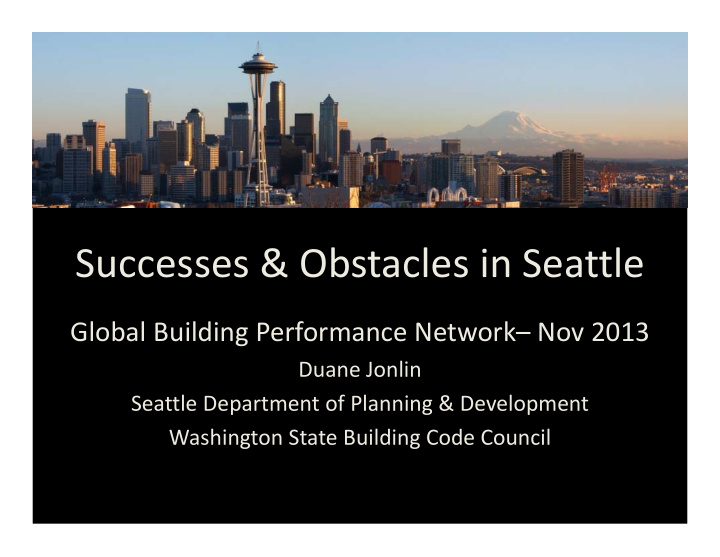



Successes & Obstacles in Seattle Global Building Performance Network– Nov 2013 Duane Jonlin Seattle Department of Planning & Development Washington State Building Code Council
Washington State Goals: The Hard Part is in the Future
But, Everything is Relative
Political Considerations = Financial Considerations Good economy – easier to move forward Bad economy – harder to create new rules Global warming & climate change – far away Cost and disruption for business – right here Activists – concerned about climate change Business – concerned about profit
“That which exists must be possible.” RFM offices in Bremerton operating at 61 kWh/M2 Federal Center South in Seattle at 71 kWh/M2 Bullitt Foundation in Seattle at Net Zero Energy 32,700 M 2 National Renewable Energy Laboratory in Colorado at Net Zero Energy Public schools in Kentucky at 60 – 70 kWh/M 2 (and now one at Net Zero Energy)
Long ‐ term planning & Near ‐ term disruption • Don’t tell me how to run my business! • Long ‐ term savings are great, but up ‐ front costs and risks are very unpopular • Long ‐ term goals don’t inform the first steps • The bandage question: What hurts more? – Pull it off a little bit at a time – Rip it all off at once
Difficult to create high performance standards for new buildings • …but even more difficult to impose strict standards for old buildings One idea: • Set existing building performance requirements for 2030 (or whenever) • Offer good incentives to do it now… • …but reduce the incentive every year
Energy Code defines the “Worst Allowable Building” • Now need hundreds of “Best Possible Buildings” • Defines next “worst allowable building” standard • Could “worst” buildings subsidize “best” buildings?
Market Support for Change? • All regulations are bad • All taxes are bad • All construction costs are bad – Even if long ‐ term costs lower However, some business leaders support change – make sure they are heard!
Encouraging market support • Make new energy codes financially sound • Be ready to explain that clearly • Convince bankers and appraisers • Publicly label building performance
How much does efficiency cost? • Anything “new” costs more • Cost lowers as “new” becomes “normal” • Need visible high ‐ performers in town • Expensive energy = cheap efficiency • Costs lower if you do everything in the building right simultaneously
Target Performance Path • Design team can toss out the energy code • Predict performance with energy modeling • Prove performance with 12 months’ operation • Back up with financial security
Commissioning • Designed operation = actual operation • Extends past construction into occupancy • Separate permit required to complete tests and correct deficiencies
Substantial Alterations • Once in a generation opportunity • Most economical moment for upgrade • Almost full code compliance required
Solar power: today leads to tomorrow • A little solar power required now • Half of roof reserved for solar in the future
Large Tenant Sub ‐ metering • Large tenant gets electrical use “dashboard” • Tenant can monitor (and manage) energy use • Give control to the people who can act on it
Plug Load Controls • In offices & classrooms, half of electrical outlets controlled by time clock or occupancy sensor. • Plug loads represent 20% 30 ‐ 40% of commercial building energy use
The best path to our goal? Floor vs. Ceiling • Raise the “ceiling” with high performing buildings – Re ‐ define what’s normal • Raise the “floor” steadily with the energy code – The “ankle breaker” • Learn from adversaries • Focus on measured results
Recommend
More recommend